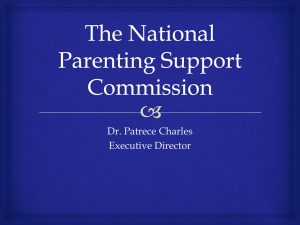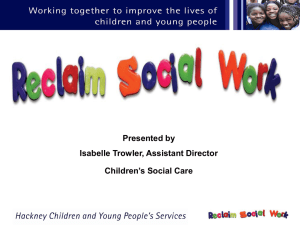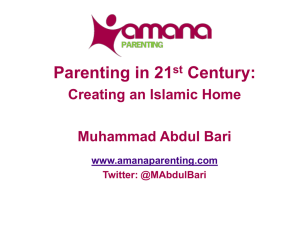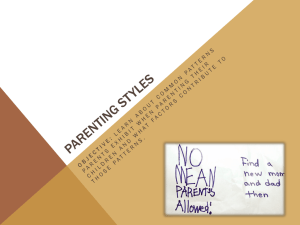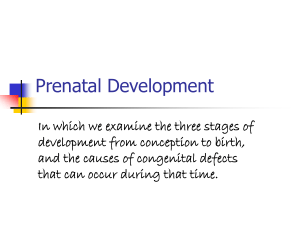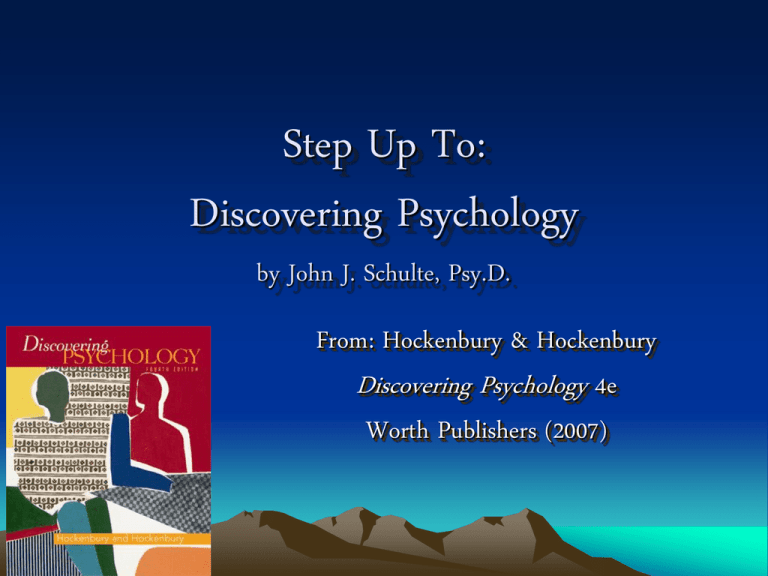
Step Up To:
Discovering Psychology
by John J. Schulte, Psy.D.
From: Hockenbury & Hockenbury
Discovering Psychology 4e
Worth Publishers (2007)
Chapter 9: Lifespan Development
Rock ‘n Roll
Early Beginnings
Designer Genes
All Grown Up
Words of Wisdom
Designer Genes
500
400
300
200
100
Early Beginnings
500
400
300
200
100
Rock ‘n Roll
500
400
300
200
100
All Grown Up
500
400
300
200
100
Words of Wisdom
500
400
300
200
100
1. A single human zygote has:
•
•
•
•
A) 23 chromosomes.
B) 46 chromosomes.
C) 23 genes.
D) 46 genes.
2. In which order do the three
phases of prenatal development
take place?
•
•
•
•
A) embryonic, fetal, germinal
B) zygotic, fetal, embryonic
C) fertile, fetal, terminal
D) germinal, embryonic, fetal
3. A person’s phenotype is the result of:
• A) the interaction of genetics and
environmental factors.
• B) genotypes from both parents.
• C) dominant genetic traits.
• D) alleles that are active during
the zygotic period.
4. Teratogens are:
• A) recessive genes that result in birth
defects.
• B) microorganisms that can cause
mutations in normal development.
• C) toxic agents that can cause defects in
an embryo or fetus.
• D) alleles that react negatively to
the environment.
5. A person’s genotype can be
accurately compared to a:
•
•
•
•
A) map of prenatal development.
B) blueprint for our development.
C) cookbook for building proteins.
D) history book of family phenotypes.
6. Touching a newborn’s cheek can cause
it to turn its head toward the source of the
touch and open its mouth. This is called
the ____ reflex.
•
•
•
•
A) sucking
B) rooting
C) grasping
D) nuzzling
7. An insecurely attached infant is:
• A) less likely to explore the environment,
even when the mother is present.
• B) less likely to explore the environment,
except when the mother is present.
• C) more likely to explore the environment
regardless of who is present.
• D) is more strongly attached to
his/her parent.
8. Motherese is:
•
•
•
•
A) ineffective mothering.
B) common mothering behavior.
C) infant-directed speech.
D) communication between
mothers.
9. Object permanence occurs by the
end of the ____ stage.
•
•
•
•
A) concrete operational
B) preoperational
C) formal operational
D) sensorimotor
10. According to Vygotsky, the zone of
proximal development is:
• A) the test of object permanence in babies.
• B) the reaction to the Strange Situation.
• C) the intermediary stage between concrete and
formal operational stages.
• D) the gap between what children can
accomplish on their own and what they can
accomplish with others more competent.
11. An adolescent’s occasional
impulsive and immature behavior is
at least partly a reflection of the last
brain area to mature, the ____:
•
•
•
•
A) pre-frontal cortex.
B) temporal lobe.
C) parietal lobe.
D) occipital lobes.
12. Changes in height, weight, body hair,
voice changes, and in girls, breast
development, that happen in
adolescence are called:
•
•
•
•
A) menarche.
B) puberty.
C) secondary sex characteristics.
D) primary sex characteristics.
13. According to Erik Erikson’s
Psychosocial Stages of Development,
adolescents must deal with the
psychosocial conflict of:
•
•
•
•
A) intimacy vs. isolation.
B) identity vs. role confusion.
C) industry vs. inferiority.
D) initiative vs. guilt.
14. In Erikson’s theory, before an adolescent
arrives at an integrated identity, there is a
time during which he/she experiments with
different roles, values and beliefs, called:
•
•
•
•
A) juvenile delinquency.
B) a moratorium period.
C) role confusion.
D) puberty.
15. Due to changes in health and
nutrition over the past 150 years, the
average age of menarche in the United
States has changed from:
•
•
•
•
A) 16 years to 14 years.
B) 18 years to 15 years.
C) 17 years to 12 years.
D) 16 years to 11 years.
16. During middle adulthood, the primary
psychosocial task is to:
• A) experiment with different roles.
• B) review his or her life to find
meaningfulness.
• C) establish lasting and meaningful
relationships.
• D) contribute to future generations.
17. When children leave home, their
parents:
• A) usually end up in divorce.
• B) show increased marital
satisfaction.
• C) become depressed.
• D) most often change their jobs.
18. Compared to couples in the 1960’s, the
average age of first marriages today is:
• A) older for females and younger for
males.
• B) younger for both males and
females.
• C) older for both males and females.
• D) older for males and younger for
females.
19. Menopause usually occurs during a
woman’s:
•
•
•
•
A) late 30’s to early 50’s.
B) early 40’s to late 50’s.
C) early 50’s to late 60’s.
D) late 40’s to early 60’s.
20. With regards to finding a mate,
people tend to:
• A) be attracted to those of opposite
values and beliefs.
• B) be attracted to those most like
themselves.
• C) be attracted to those most approved
of by their parents.
• D) be attracted to those most likely
to be successful and wealthy.
21. In the U.S., most adults over the
age of 65:
•
•
•
•
A) live in nursing homes.
B) live with relatives.
C) live in senior citizen communities.
D) live in their own homes.
22. According to the activity theory of
aging:
• A) activity has a gradual decline in late
adulthood.
• B) activity level declines with a decline in
life satisfaction.
• C) activity remains higher in married
couples.
• D) life satisfaction is highest when
you maintain your previous level of
activity.
23. According to Erik Erikson’s stages, an
elderly person much reach the level of ____
or the result is ____.
•
•
•
•
A) generativity; stagnation.
B) ego integrity; despair.
C) wisdom; anxiety.
D) intimacy; isolation.
24: The most recommended parenting style,
in which parents set clear standards for
their children’s behavior but are also
responsive to their children’s wishes, is:
•
•
•
•
A) permissive parenting.
B) authoritarian parenting.
C) authoritative parenting.
D) induction parenting.
25. According to Elisabeth Kübler-Ross,
dying individuals go through five stages,
including all of the following except:
•
•
•
•
A) depression.
B) denial.
C) bargaining.
D) shock.
Stop here, or continue as a review
1. A single human zygote has:
•
•
•
•
A) 23 chromosomes.
B) 46 chromosomes.
C) 23 genes.
D) 46 genes.
352
2. In which order do the three
phases of prenatal development
take place?
•
•
•
•
A) embryonic, fetal, germinal
B) zygotic, fetal, embryonic
C) fertile, fetal, terminal
D) germinal, embryonic, fetal
355
3. A person’s phenotype is the result of:
• A) the interaction of genetics and
environmental factors.
• B) genotypes from both parents.
• C) dominant genetic traits.
• D) alleles that are active during
the zygotic period.
354
4. Teratogens are:
• A) recessive genes that result in birth
defects.
• B) microorganisms that can cause
mutations in normal development.
• C) toxic agents that can cause defects in
an embryo or fetus.
• D) alleles that react negatively to
the environment.
356
5. A person’s genotype can be
accurately compared to a:
•
•
•
•
A) map of prenatal development.
B) blueprint for our development.
C) cookbook for building proteins.
D) history book of family phenotypes.
354
6. Touching a newborn’s cheek can cause
it to turn its head toward the source of the
touch and open its mouth. This is called
the ____ reflex.
•
•
•
•
A) sucking
B) rooting
C) grasping
D) nuzzling
357
7. An insecurely attached infant is:
• A) less likely to explore the environment,
even when the mother is present.
• B) less likely to explore the environment,
except when the mother is present.
• C) more likely to explore the environment
regardless of who is present.
• D) is more strongly attached to
his/her parent.
361
8. Motherese is:
•
•
•
•
A) ineffective mothering.
B) common mothering behavior.
C) infant-directed speech.
D) communication between
mothers.
363
9. Object permanence occurs by the
end of the ____ stage.
•
•
•
•
A) concrete operational
B) preoperational
C) formal operational
D) sensorimotor
369
10. According to Vygotsky, the zone of
proximal development is:
• A) the test of object permanence in
babies.
• B) the reaction to the Strange Situation.
• C) the intermediary stage between
concrete and formal operational stages.
• D) the gap between what children can
accomplish on their own and what
they can accomplish with others more
competent.
373
11. An adolescent’s occasional
impulsive and immature behavior is
at least partly a reflection of the last
brain area to mature, the ____:
•
•
•
•
A) pre-frontal cortex.
B) temporal lobe.
C) parietal lobe.
D) occipital lobes.
377
12. Changes in height, weight, body hair,
voice changes, and in girls, breast
development, that happen in
adolescence are called:
•
•
•
•
A) menarche.
B) puberty.
C) secondary sex characteristics.
D) primary sex characteristics.
375
13. According to Erik Erikson’s
Psychosocial Stages of Development,
adolescents must deal with the
psychosocial conflict of:
•
•
•
•
A) intimacy vs. isolation.
B) identity vs. role confusion.
C) industry vs. inferiority.
D) initiative vs. guilt.
381
14. In Erikson’s theory, before an adolescent
arrives at an integrated identity, there is a
time during which he/she experiments with
different roles, values and beliefs, called:
•
•
•
•
A) juvenile delinquency.
B) a moratorium period.
C) role confusion.
D) puberty.
380
15. Due to changes in health and
nutrition over the past 150 years, the
average age of menarche in the United
States has changed from:
•
•
•
•
A) 16 years to 14 years.
B) 18 years to 15 years.
C) 17 years to 12 years.
D) 16 years to 11 years.
376
16. During middle adulthood, the primary
psychosocial task is to:
• A) experiment with different roles.
• B) review his or her life to find
meaningfulness.
• C) establish lasting and meaningful
relationships.
• D) contribute to future generations.
382
17. When children leave home, their
parents:
• A) usually end up in divorce.
• B) show increased marital
satisfaction.
• C) become depressed.
• D) most often change their jobs.
384
18. Compared to couples in the 1960’s, the
average age of first marriages today is:
• A) older for females and younger for
males.
• B) younger for both males and
females.
• C) older for both males and females.
• D) older for males and younger for
females.
383
19. Menopause usually occurs during a
woman’s:
•
•
•
•
A) late 30’s to early 50’s.
B) early 40’s to late 50’s.
C) early 50’s to late 60’s.
D) late 40’s to early 60’s.
382
20. With regards to finding a mate,
people tend to:
• A) be attracted to those of opposite
values and beliefs.
• B) be attracted to those most like
themselves.
• C) be attracted to those most approved
of by their parents.
• D) be attracted to those most likely
to be successful and wealthy.
383
21. In the U.S., most adults over the
age of 65:
•
•
•
•
A) live in nursing homes.
B) live with relatives.
C) live in senior citizen communities.
D) live in their own homes.
385
22. According to the activity theory of
aging:
• A) activity has a gradual decline in late
adulthood.
• B) activity level declines with a decline in
life satisfaction.
• C) activity remains higher in married
couples.
• D) life satisfaction is highest when
you maintain your previous level of
activity.
386
23. According to Erik Erikson’s stages, an
elderly person much reach the level of ____
or the result is ____.
•
•
•
•
A) generativity; stagnation.
B) ego integrity; despair.
C) wisdom; anxiety.
D) intimacy; isolation.
387
24: The most recommended parenting style,
in which parents set clear standards for
their children’s behavior but are also
responsive to their children’s wishes, is:
•
•
•
•
A) permissive parenting.
B) authoritarian parenting.
C) authoritative parenting.
D) induction parenting.
388
25. According to Elisabeth Kübler-Ross,
dying individuals go through five stages,
including all of the following except:
•
•
•
•
A) depression.
B) denial.
C) bargaining.
D) shock.
388
Acknowledgments
• Step Up Created by:
John J. Schulte, Psy.D.
• Based on Discovering
Psychology 4e by
Hockenbury & Hockenbury
• Worth Publishers, 2007
Answers
1.
2.
3.
4.
5.
6.
7.
8.
B
D
A
C
C
B
A
C
9.
10.
11.
12.
13.
14.
15.
16.
D
D
A
C
B
B
C
D
17.
18.
19.
20.
21.
22.
23.
24.
B
C
A
B
D
D
A
C
25. D





